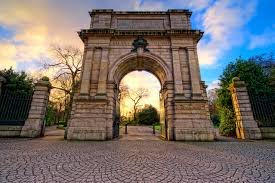St. Stephen’s Green, located at the end of Grafton St, is a beautiful park that has been a central feature of the city for centuries. This wonderful landscaped area, with its lush greenery and gentle atmosphere, serves as a tranquil space amidst the busy city environment. The Green’s past and present make it a popular destination for both tourists and Dubliners.
A Brief History of St. Stephen’s Green
St. Stephen’s Green has a history that dates back to medieval times. Initially, the area was a marshy common used for grazing. The transformation of the Green began in 1663 when an Act of Parliament was passed to enclose the land, and it was subsequently laid out as a park.
- 17th Century: In 1664, the Green was enclosed with a stone wall, and the surrounding plots were sold for the development of Georgian-style houses. This marked the beginning of its evolution into a formal park. However, it remained relatively inaccessible to the general public, reserved primarily for the wealthy residents who lived nearby.
- 19th Century: The most significant changes came in the 19th century, particularly in 1877, when Sir Arthur Guinness, Lord Ardilaun, funded a major redesign and landscaping of the park. The design aimed to create a public space that was both beautiful and accessible to all citizens of Dublin. The park was officially reopened by Lord Ardilaun and has since been open to the public.
- Easter Rising of 1916: St. Stephen’s Green played a notable role during the Easter Rising of 1916, a pivotal event in Irish history. The park was occupied by the Irish Citizen Army, led by Michael Mallin and Countess Markievicz. Trenches were dug, and the park became a battleground. Today, a statue of Countess Markievicz commemorates her contribution to the uprising.
The Park’s Features and Attractions
St. Stephen’s Green spans 22 acres and is a delightful blend of manicured gardens, natural landscapes, and historical monuments. It offers attractions that appeal to visitors of all ages.
- The Fusiliers’ Arch: Located at the Grafton Street entrance, this archway is a prominent feature of the Green. It was erected to commemorate the Royal Dublin Fusiliers who died in the Second Boer War.
- Ornamental Lake and Waterfall: One of the most picturesque areas of the park is the ornamental lake, complete with a waterfall and a charming bridge. This area is a haven for ducks and other wildlife, adding to the park’s tranquil ambiance.
- Victorian Layout: The park retains much of its Victorian layout, with tree-lined walkways, formal flower beds, and a variety of sculptures and fountains. The central flowerbeds are particularly notable for their vibrant displays, which change with the seasons.
- Playground and Picnic Areas: For families, the park offers a playground and plenty of open spaces perfect for picnics. The relaxed environment makes it an ideal spot for leisurely afternoons.

Cultural and Social Significance
St. Stephen’s Green central location and historical significance make it a popular venue for various events and activities throughout the year.
- Concerts and Performances: The bandstand, located near the center of the park, often hosts concerts and performances, particularly during the summer months. These events can draw large crowds particularly if the sun is out!
- Literary Connections: The park has inspired numerous writers and artists over the years. James Joyce, in particular, referenced St. Stephen’s Green in his works, highlighting its importance in Dublin’s cultural landscape.
- Memorials and Statues: Scattered throughout the park are various memorials and statues that honor notable figures and events in Irish history. These include a bust of James Joyce, a memorial to the Great Famine, and statues of historical figures like Robert Emmet and Wolfe Tone.
Modern-Day St. Stephen’s Green
Today, St. Stephen’s Green remains an important part of Dublin. Its proximity to major shopping streets like Grafton Street and its adjacency to cultural institutions such as the Little Museum of Dublin and the National Gallery make it a convenient and attractive destination.
- Accessibility: The park is easily accessible by public transportation, with the St. Stephen’s Green Luas stop providing direct access to the park. In addition there are lots of interesting streets in the vicinity that you can explore.
- Community Engagement: The park continues to play a vital role in the city, hosting events such as outdoor yoga classes, guided historical tours, and seasonal festivals.
Conclusion
St. Stephen’s Green is important both historically and culturally for the city of Dublin. It has a long history, from its medieval origins to its role in the Easter Rising. Today, the park serves as a peaceful retreat and a cultural hub. Whether you’re a history enthusiast, a nature lover, or simply looking for a nice spot to relax, St. Stephen’s Green offers something for everyone.